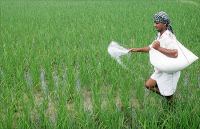 N
Nutrient Based Subsidy has improved the availability of fertilizer; government actively considering extension of the NBS regime to cover urea.
Government plans to move towards direct transfer of cash subsidy to people living below poverty line in a phased manner for better delivery of kerosene, LPG and fertilizers. Task force has been set up to work out the modalities for the proposed system. The fertilizer subsidy has been cut from Rs. 54,976.68 crore (revised estimates) for FY 2010-11 to Rs. 49,997.87 crore (Budget estimates) for FY 2011-12.
Current surcharge of 7.5 per cent on domestic companies proposed to be reduced to 5 per cent. Minimum Alternative Tax increased from 18 per cent to 18.5 per cent of book profits.
Lower rate of 15 per cent tax on dividends received by an Indian company from its foreign subsidiary Service tax rate held at 10 percent.
Budget Impact:
Investment-linked deduction for fertilizer, as well as treating capital investment in fertiliser sector as an infrastructure sub-sector industry is positive.
These measures will boost the payback period on the one hand, and reduce the cost and improve the availability of finance for capital expenditure in the fertilizer sector. The country witnessed very few Greenfield and Brownfield projects in the fertilizer sector. In this context, the above two measures have come as a fillip, thereby facilitating stepping up of investment in the fertilizer sector.
In line with the industry expectations, the government has indicated that it is actively considering extension of the NBS regime to cover urea.
Similarly, the move towards direct transfer of cash subsidy is positive. Though the government is only subsidizing the farmers, in the present form, it appears as if the industry is benefiting from thee subsidies. Industry will shed such stigma after direct transfer of cash subsidy to farmers.
This will take time to implement, but once implemented properly, it will substantially improve the profitability of stronger players, and weed out inefficient players.
Meanwhile, the global fertilizer prices have
flared up, which calls for either substantial rise in the per tonne subsidy or significant hike in the farm gate fertiliser prices, or a judicious mix of both.
The International Urea prices have flared up from $229.30 per tonne in June 2010 to $374.1 per tonne by January 2011.
Similarly, DAP prices have hardened from $448.00 per tonne in June 2010 to $595.8 per tonne by January 2011. Potassium Chloride (Muriate of Potash) prices have also hardened from $314.40 per tonne in April 2010 to $367.50 per tonne by January 2011.
Despite such hardening prices, the government had earlier slashed the per tonne Nutrient Based Subsidy for FY 2011-12 from FY 2010-11 levels.
Accordingly, the fertilizer subsidy has been cut from 54,976.68 crore (revised estimates) for FY 2010-11 to Rs. 49,997.87 crore (Budget estimates) for FY 2011-12.
We believe that the final subsidy payment by the government will be significantly higher, and until the higher allocation is approved by the parliament, there could be delays in payment of subsidies for fertilizers during the second half of FY 2011-12.
Stocks to watch:
Deepak Fertilizers and Petrochemicals, Tata Chemicals, Rashtriya Chemicals and Fertilizers, Gujarat Narmada Valley Fertilizer Corporation
Outlook:The extension of benefit of investment-linked deduction has been extended to businesses engaged in the production of fertilizers.
Similarly, capital investment in fertilizer production proposed to be included as an infrastructure sub-sector. These two factors should improve the attractiveness of investment in Indian fertilizer sector.
But there is uncertainty on how much the government will increase per tonne subsidy for FY 2011-12 in lieu of hardening global prices, and how much the farmer level prices will be allowed to be increased. So, while the long-term road map is much clear, the short term visibility/clarity is missing.
Overall, the Union Budget 2011-12 was positive for the fertilizer sector.


 Nutrient Based Subsidy has improved the availability of fertilizer; government actively considering extension of the NBS regime to cover urea.
Nutrient Based Subsidy has improved the availability of fertilizer; government actively considering extension of the NBS regime to cover urea.